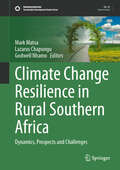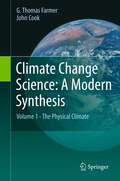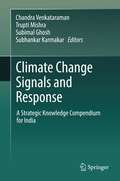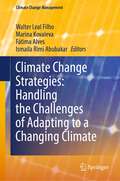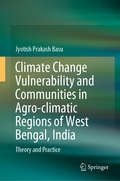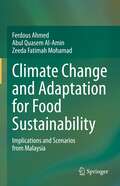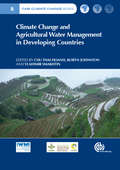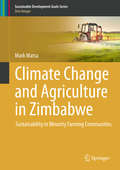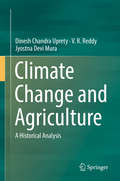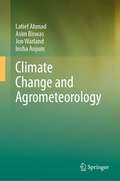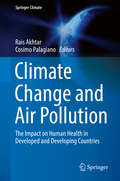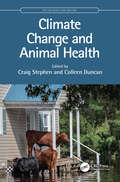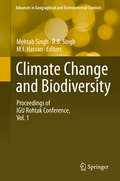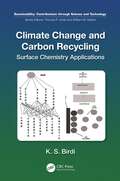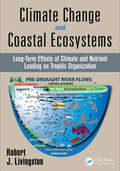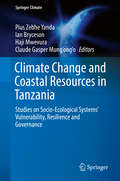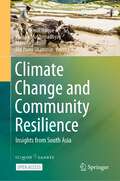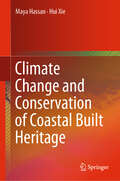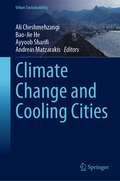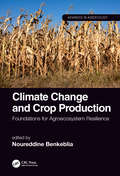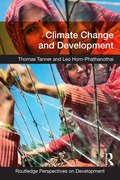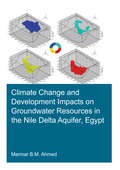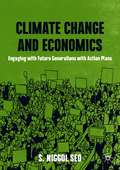- Table View
- List View
Climate Change Resilience in Rural Southern Africa: Dynamics, Prospects and Challenges (Sustainable Development Goals Series)
by Godwell Nhamo Mark Matsa Lazarus ChapunguIn rural Southern Africa, the livelihoods of millions are intricately linked to the land, water, and ecosystems that are increasingly under threat from climate change. This intensifying threat has exacerbated pre-existing vulnerabilities, rendering the need for resilience building more critical than ever. Emerging scholarship on climate change strategies suggest that building resilience in human and environmental systems is the ideal strategy for combating the climate change induced catastrophes. Rural Southern Africa has witnessed both isolated and coordinated efforts by various stakeholders to bolster climate resilience, yielding varying degrees of success. This book offers a comprehensive examination of the rural Southern African landscape, probing the intricate dynamics, prospects, and challenges associated with building climate resilience. It examines how traditional knowledge, innovative practices (including Artificial Intelligence), and sustainable development strategies are converging to create resilient systems. The book further highlights the critical role of local communities in addressing climate challenges and offers actionable insights for a more resilient future. It emerged that some interventions have managed to build resilience of at-risk households, communities and systems, while others have faced significant challenges. In general, climate resilience building remains complex and lagging due to increased vulnerabilities induced by global disease emergencies such as COVID-19, increased poverty due to global recessions, poor governance, corruption and several other internal and external factors. Therefore, the need to increase cooperation amongst Southern African states to pursue common development goals cannot be overemphasized. Rich with case studies, expert analyses, and systematic reviews, this book is an essential read for policymakers, researchers, and those invested in the future of rural Southern Africa.
Climate Change Science: Volume 1 - The Physical Climate
by John Cook G. Thomas FarmerAn introduction to the principles of climate change science with an emphasis on the empirical evidence for climate change and a warming world. Additional readings are given at the end of each chapter. A list of "Things to Know" opens each chapter. Chapters are arranged so that the student is first introduced to the scientific method(s), examples of the use of the scientific method from other sciences drawn from the history of science with an emphasis on climate science. Climate science is treated in each chapter based on the premise of global warming. Chapter treatments on the atmosphere. biosphere, geosphere, hydrosphere, and anthroposphere and their inter-relationships are given.
Climate Change Signals and Response: A Strategic Knowledge Compendium for India
by Chandra Venkataraman Trupti Mishra Subimal Ghosh Subhankar KarmakarThis book provides a synthesis of research findings, in terms of strategic knowledge outcomes regarding emergence of recent regional climate signals, implications for impacts assessment, and mitigation and adaptation response, relevant in the Indian context. The first part discusses evidence of climate change and its underlying scientific processes across India, chiefly focusing on impacts that are already visible and attributable to anthropogenic activities. The latter part deals with the responses to climate change, highlighting the mitigation and adaptation strategies in various sectors and communities.The book presents a concise interpretation, distilling practical recommendations and policy prescriptions at national and sub-national levels. It serves as a reference point for understanding scientific advances and persisting uncertainty, future vulnerability and response capacity of interlinked human and natural systems, pertaining to India. It is an excellent resource for policy makers and industry watchers in addition to the research fraternity.
Climate Change Strategies: Handling the Challenges of Adapting to a Changing Climate (Climate Change Management)
by Walter Leal Filho Marina Kovaleva Fátima Alves Ismaila Rimi AbubakarThis book includes information, experiences, practical initiatives and projects around the subject matter and makes it available to a wide audience. It addresses the scientific, social, political and cultural aspects of climate change impacts and respective solutions in an integrated and coherent way.Climate change as a global phenomenon imposes new challenges for survival. Extreme weather events including heat waves, storms, droughts as well as rising sea levels, warming oceans and melting glaciers threaten people's livelihoods and communities, ecosystems and habitats. Furthermore, it affects the entire food chain and increases competition for natural resources fuelling socioeconomic tensions. The results of the latest IPCC report highlight the urgent need for combating climate change. The adaptation measures to be undertaken range across sectors, thematic fields and geographical locations.Based on this need, the book focuses on the high-quality, interdisciplinary contributions on the scientific, social, economic, political and cultural aspects of climate change challenges and solutions
Climate Change Vulnerability and Communities in Agro-climatic Regions of West Bengal, India: Theory and Practice
by Jyotish Prakash BasuThis book addresses the quantitative measurement of climate change vulnerability at the macro and micro-level and identifies household adaptation strategies to cope with the adverse effects of climate change. Focusing on five different agro-climatic regions of West Bengal: the hill region, foothill region, drought region, and coastal regions of Sunderban and Purba Midnapore, it presents research related to various sectors, including the agricultural, forestry and informal sectors. The book also offers insights into the impact of climate change on smallholdings, forest-dependent communities, fishing and crab collecting communities, casual labourers and workers in the informal sectors, and identifies the key vulnerabilities associated with climate change, as well as the causes of such vulnerability the extent to which remedial measures have been taken. The book particularly highlights the role of Indian governmental policies like Sarva Shiksa Abhiyan, Mahatma Gandhi National Rural Employment Guarantee Act (MGNREGA), the housing scheme, Indira Awas Yojana, the Food for Work Programme, and the rural road building scheme, Pradhan Mantri Grameen Sadak Yojana, which are important for rural development and in reducing vulnerability. Showcasing vulnerability measurement in the socio-ecological system, the book will appeal to developmental practitioners, government implementation agencies, policymakers and researchers in the field of environmental science and policymakers will find this book appealing.
Climate Change and Adaptation for Food Sustainability: Implications and Scenarios from Malaysia
by Ferdous Ahmed Abul Quasem Al-Amin Zeeda Fatimah MohamadThis book assesses the vulnerability impacts of climate change on food security by examining a 50 years scenario (2015- 2065) and following a top-down approach. Importantly, looking at the sustainable food production, the authors compared the cost-benefit of adaptation costs from 2015 to 2065. It was found that a 15% adaptation capacity is more efficient for Malaysia in order to combat the climate change effects on the food sector. This book has developed a quantitative adaptive model namely, the Malaysian Climate and Economy (MCE) model, based on the dynamic Computable General Equilibrium (CGE) modeling structure to examine food sustainability and adaptation strategies. Malaysia experiences an unusual combination of droughts and extreme rainfall events that can be attributed to climate change. These unusual events and consequences leave Malaysian policymakers looking for ways to make Malaysia self-sufficient in terms of agriculture. It is assumed that climate change effects may result in increasing food insecurity and vulnerability in the future. Policy measures are in place to lessen the likely climatic effects overall, but there is an urgent need to develop an adaptation policy for the future.
Climate Change and Agricultural Water Management in Developing Countries
by Suan Pheng Kam Robyn Johnston Liu Qin Diana Suhardiman E Lisa Schipper Xueliang Cai Matthew Mccartney Mannapova Dilafruz Vladimir Smakhtin Felino P Lansigan Ngo Dang Phong Karen Villholth Aditya Sood Chu Hoanh Chayanis Krittasudthacheewa Kuppannan Palanisami Bjoern Ole SanderThe book provides an analysis of impacts of climate change on water for agriculture, and the adaptation strategies in water management to deal with these impacts. Chapters include an assessment at global level, with details on impacts in various countries. Adaptation measures including groundwater management, water storage, small and large scale irrigation to support agriculture and aquaculture are presented. Agricultural implications of sea level rise, as a subsequent impact of climate change, are also examined.
Climate Change and Agricultural Water Management in Developing Countries (CABI Climate Change Series #3)
by Suan Pheng Kam Liu Qin Diana Suhardiman E Lisa Schipper Xueliang Cai Mannapova Dilafruz Felino P Lansigan Ngo Dang Phong Karen Villholth Aditya Sood Chayanis Krittasudthacheewa Kuppannan Palanisami Bjoern Ole Sander Matthew McCartneyThe book provides an analysis of impacts of climate change on water for agriculture, and the adaptation strategies in water management to deal with these impacts. Chapters include an assessment at global level, with details on impacts in various countries. Adaptation measures including groundwater management, water storage, small and large scale irrigation to support agriculture and aquaculture are presented. Agricultural implications of sea level rise, as a subsequent impact of climate change, are also examined.
Climate Change and Agriculture in Zimbabwe: Sustainability in Minority Farming Communities (Sustainable Development Goals Series)
by Mark MatsaThis book proves, through empirical research, that indigenous and traditional agricultural communities have experienced severe climate change impacts, and have developed corresponding livelihood strategies to strengthen their resilience in a variable climate. With a focus on indigenous minority farming communities in the developing region of South-Western Zimbabwe, the study presents both qualitative and quantitative approaches of data analysis to assess sustainability problems amid climate change and climate variability challenges, and proposes potential solutions. In eight chapters, the book expands on the scarce availability of community-based research on climate change and variability in Zimbabwe.The book is meant for college and university students and stakeholders involved in development work in rural minority farmer communities, especially in climate change prone regions of Africa and other developing countries who have very few options of adaptation and mitigation.
Climate Change and Agriculture: A Historical Analysis
by Dinesh Chandra Uprety V. R. Reddy Jyostna Devi MuraThis book discusses the history of environmental science and climate change, and the initiation and development of different parameters determining climate changes. The account of the history of such changes and turmoil in India and abroad starts in the prehistoric period, long before the emergence of “Rigveda”, the first human written work. The book describes the writings of Aristotle and Theophrastus on climatic disasters and their impact on the vegetation and society in Greek and Roman history, and addresses different studies related to climate change during the prehistoric period and their chronological development. The first book of its kind, it enhances our understanding the origin of research on climate change and climate related problems, and as such is a valuable resource for postgraduate students of agriculture and environment sciences, research scholars, scientists, environmentalists and policy planners.
Climate Change and Agrometeorology
by Latief Ahmad Asim Biswas Jon Warland Insha AnjumThe monograph focuses on agricultural meteorology and climate change and its impacts on different crops. Comprising of chapters from experts, the book discusses and provides first-hand information to the long term shifts in weather patterns and temperature impacting soil, water and crops. Each chapter focuses in detail on the impact of plant- water – soil nexus and climate change on agriculture and food security. Covering the basic concepts about the temperature, pressure and humidity correlation with the increased demands of food, the book explores in detail the impact of adverse climatic conditions like drought, floods, increasing levels of carbon dioxide emissions and other simultaneous effects like soil fertility depletion on the cropping systems and overall crop productivity. The book touches the challenges of climate change, adaptive methods, mitigation strategies, with careful explanation of governance, plans and policies required to provide guidelines to stake holders so they can best prepare for the negative climate change impacts. While touching the agricultural challenges faced globally due to climate change, the book serves as a reference book for students, researchers and policy makers, involved in horticulture, agriculture and environmental sciences and climate change.
Climate Change and Air Pollution: The Impact on Human Health in Developed and Developing Countries (Springer Climate)
by Rais Akhtar Cosimo PalagianoThis book discusses regional and international climate-change, air- pollution and human-health scenarios. The research, from both industrialized and developing countries, focuses on region-specific perspectives of climate change impacts on air pollution. After analyzing the variations of climate data over recent decades, the authors consider the different effects of climate change on air pollution and health. As stressed by the IPCC, "pollen, smoke and ozone levels are likely to increase in a warming world, affecting the health of residents of major cities. Rising temperatures will worsen air quality through a combination of more ozone in cities, bigger wild fires and worse pollen outbreaks," according to a major UN climate report. The report follows the World Health Organization in finding that air pollution is the world's greatest environmental health risk, killing 7 million people in 2014 (compared to 0. 4 million deaths due to malaria). Deteriorating air quality will most affect the elderly, children, people with chronic ill-health and expectant mothers. Another report suggests that more than 5. 5 million people die prematurely each year due to air pollution with over half of those deaths occurring in China and India. A study on the air pollution in the USA,suggests that more than half of US population lives in areas with potentially dangerous air pollution, and about six out of 10 of the top cities for air pollution in the USA are located in the state of California. In the face of future climate change, scientists have urged stronger emission controls to avoid worsening air pollution and the associated exacerbation of health problems, especially in more populated regions of the world. It is hoped that the implementation of the Paris Climate Agreement will help minimize air pollution. Additionally the authors consider the various measures that different countries and groups of countries, like the European Union, have adopted to mitigate the problems arising from climate change and to safeguard the health of population. The book examines the increasing incidence of diseases largely caused by climate change. The countries/regions covered in this study include the USA, Northern Europe (U. K). ,Southern Europe ( Italy), Canada, Australia, East Asia, Russia, Hong Kong, Taiwan, Thailand, Malaysia, Indonesia, India, South Africa, Mexico, Brazil, Caribbean countries, and Argentina.
Climate Change and Animal Health (CRC One Health One Welfare)
by Colleen Duncan Craig StephenThis benchmark publication assembles information on the current and anticipated effects of climate change on animal health. It empowers educators, managers, practitioners, and researchers by providing evidence, experience, and opinions on what we need to do to prepare for, and cope with, the largest threat ever to have faced animals on this planet. With expert contributors from across the globe, the text equips the reader with information and means to develop sustainable adaptation or mitigation actions. After introducing animal health in a climate change context, chapters look at specific animal health impacts arising from climate change. The book concludes with suggestions on teachable and actionable ideas that could be used to mobilize concepts provided into education or advocacy. This book was written amid the COVID-19 pandemic and in the face of ever-increasing reports of on-the-ground, real-life climate impacts. Large scale wildfire and ocean heat waves killed unprecedented numbers of animals while droughts in some areas and floods in others displaced thousands of livestock and made food scarce for even more. Climate change is real, and it is here. How we respond will have profound implications for people, biodiversity, welfare, conservation, societies, economies and ecosystems. Today's veterinary educators are awakening to the need to adapt and train a new generation of animal health professions who can understand and plan for climate change, and this book is an essential resource.
Climate Change and Atmospheric Deposition as Drivers of Forest Ecosystem Integrity and Services: A Methodology for Assessing and Mapping Ecosystem Services across Time and Space (SpringerBriefs in Environmental Science)
by Winfried Schröder Angela SchlutowThis book is intended to provide a hitherto missing English-language overview of a multi-year research project in which a comprehensive methodology was developed to assess a rule-based classification of the habitat services, the primary net biomass productivity and carbon sequestration capacity. The comprehensive methodology presented operationalises the specifications of the MAES working group quantitatively. The MAES classification framework for integrative ecosystem assessments comprises the mapping of ecosystems, the classification of ecosystem conditions (ecosystem condition information for individual indicators, ecosystem functions and ecosystem types), the classification of ecosystem services and their integration. The presented rule-based classification of the three ecosystem services examined in depth using quantitative indicators is unique in the EU to date.
Climate Change and Biodiversity: Proceedings of IGU Rohtak Conference, Vol. 1 (Advances in Geographical and Environmental Sciences)
by R. B. Singh Mehtab Singh M. I. HassanThe over-exploitation of important earth resources such as land and water has led to a number of environment-related problems the world over. At the same time, land-use change caused by various human activities has led to extinction of many plant and animal habitats and species. In this context, the relevance of biodiversity for human survival is becoming a major international political issue as scientific evidence builds on the global health implications of biodiversity loss. These issues are closely linked with the issue of climate change, as many of the health risks due to climate change are associated with rapid degradation of biodiversity. This present work focuses on holistic natural resource-based spatio-temporal planning, development, and management and considers them as essential to save the degraded ecosystem for sustainable resource management. Contributions are compiled in two volumes: 1. Climate Change and Biodiversity and 2. Landscape Ecology and Water Management. Geoinformatics along with its tools such as remote sensing and geographical information systems (GIS) have been used in assessing the results of various environmental problems both physical and social. The volume will be useful for geographers, geoscientists, hydrologists, landscape ecologists, environmentalists, engineers, planners and policy makers.
Climate Change and Carbon Recycling: Surface Chemistry Applications (ISSN)
by K. S. BirdiClimate Change and Carbon Recycling: Surface Chemistry Applications describes the application of surface chemistry methods for carbon capture and recycling in relation to climate change and atmospheric CO2 levels. The text is suitable for online education, with both basic and educational descriptions of the climate change process and carbon recycling methods like the adsorption and absorption of CO2 on solids. This book leads to a better understanding of a complex phenomenon and highlight the importance of CO2 capture and sequestration for the future to enable the utilization of fossil fuels without contributing to atmospheric greenhouse gases.Features This unique volume specifically highlights the surface chemistry aspects of carbon capture and recycling (CCR) Fills the need for an online textbook edition, which provides a basic and educational description of the climate change process and carbon capture/recycling Describes the application of surface chemistry methods for carbon capture and recycling, such as adsorption/absorption of CO2 Discusses the importance of recycling in reducing and controlling the concentration of carbon dioxide in the air (420 ppm: 0.042%) Describes the importance of the technology related to carbon capture/recycling and sequestration (CCS) from fossil fuel energy plants as a means of CO2 control
Climate Change and Coastal Ecosystems: Long-Term Effects of Climate and Nutrient Loading on Trophic Organization (CRC Marine Science)
by Robert J. LivingstonProduced by a Leading Aquatic ScientistA narrative account of how estuaries around the world are being altered by human forces and human-induced global climate changes, Climate Change and Coastal Ecosystems: Long-Term Effects of Climate and Nutrient Loading on Trophic Organization chronicles a more than 40-year-old research effort conducted by Dr.
Climate Change and Coastal Resources in Tanzania: Studies on Socio-Ecological Systems’ Vulnerability, Resilience and Governance (Springer Climate)
by Pius Zebhe Yanda Ian Bryceson Haji Mwevura Claude Gasper Mung'Ong'OThis volume synthesizes research from a five year program supported by the Norwegian Agency for Development to assess how coastal communities in Tanzania can adapt to climate change impacts such as sea level rise, and better assert their rights to implement decisions regarding coastal resource management in the context of global climate change. Throughout ten chapters, the book deploys a holistic approach to adopt a conceptual model of socio-ecological systems, and characterize human-nature interactions in an integrative way to understand anthropogenic pressures on ecosystems to guide conservation and management. The book will be of interest to researchers, students studying environmental management and climate change, planners, and policy makers. The book begins by describing the biophysical and socio-economic characteristics of the Tanzanian coastal environment, then discusses the impacts of climate change on coastal resource governance, community vulnerability, and livelihood security. Then, intervention strategies are offered as a means for local communities to not only adapt to climate change impacts, but also to engage in decision-making processes to assess vulnerabilities and address challenges and limitations through educated measures. The final chapters discuss the vulnerability and adaptation of coastal communities to climate change impacts to assess how livelihoods are constructed in response to impacts, and summarize the key findings to determine the best adaptation strategies to improve adaptive capacity and reduce socio-economic vulnerability.
Climate Change and Community Resilience: Insights from South Asia
by Pranab Mukhopadhyay A. K. Enamul Haque Mani Nepal Md Rumi ShamminThis open access book documents myriads of ways community-based climate change adaptation and resilience programs are being implemented in South Asian countries. The narrative style of writing in this volume makes it accessible to a diverse audience from academics and researchers to practitioners in various governmental, non-governmental and international agencies. At a time when climate change presents humanity with a gloomy future, the stories of innovation, creativity, grassroots engagement and locally applicable solutions highlighted in this book provides insights into hopeful ways of approaching climate solutions. South Asian countries have been dealing with the impact of climate change for decades and thus offer valuable learning opportunities for developing countries within and beyond the region as well as many western countries that are confronting the wrath of climate induced natural disasters more recently.SANDEE has been a pioneer in the development of research and training in environmental economics and related issues in South Asia and Prof Maler has been throughout SANDEE's history, its mentor, and its strongest supporter. Many young economists in South Asia have significantly benefited from Prof Maler's guidance and inputs. The present volume on “Climate Change and Community Resilience: Insights from South Asia” is a fitting tribute and an excellent reflection of Prof Maler's contributions to the SANDEE programme throughout his association.- Mahesh Banskota, Ph.D.Professor, Development StudiesSchool of Arts, Kathmandu UniversityThis comprehensive volume aptly identifies grassroots initiatives as the core of the problem of adaptation to climate change. The analysis of the different experiments is lucid, inclusive, and full of interesting detail. The methodologies used and the subjects covered span a range of frameworks and narratives. Put together, the studies are a fitting tribute to Karl-Goran Maler, who spent years putting his impeccable expertise to use for the cause of enhancing research in South Asia.- Kanchan Chopra, Ph.D.Former Director and Professor, Institute of Economic Growth, Delhi, and Fellow, SANDEEThe slow international policy response to climate change elevates the importance of understanding how communities can respond to climate change’s many threats. This unusually accessible volume provides that understanding for South Asia while being relevant to the rest of the world. Its emphasis on research by scholars from the region makes it a wonderful tribute to Prof. Karl-Göran Mäler, who contributed so much to the growth of environmental economics research capacity in South Asia.- Jeffrey R. Vincent, Ph.D.Clarence F. Korstian Professor of Forest Economics & ManagementNicholas School of the Environment, Duke University, USA
Climate Change and Conservation of Coastal Built Heritage
by Maya Hassan Hui XieThis book presents the preservation principles and the current environmental challenges relating to monitoring heritage sites and buildings under the effects of climate change. It provides a clear overview of conservation action levels and the importance of participation and cooperation between them, and discusses evaluation and management methods, thermal comfort for the common usages, and conceptual methods for enhancing the built heritage. The research presented employed the “Zoom In, Zoom Out” approach for monitoring the Syrian coastal heritage sites threatened by the direct and indirect effects of climate change. Lastly, the book establishes the basic principles and conservation strategies for preserving the coastal heritage sites and buildings. As such, it is a valuable reference resource for researchers, developers, architects, and conservators involved in protecting the architectural heritage in coastal areas. It can also be used as a guidebook on preserving and monitoring built heritage sites at both macro and micro levels.
Climate Change and Cooling Cities (Urban Sustainability)
by Ali Cheshmehzangi Ayyoob Sharifi Bao-Jie He Andreas MatzarakisThis edited book provides a solid foundation for future research on cooling cities, climate change impacts on cities and urban environments, and innovative mitigation and adaptation strategies. With ever-increasing climate change impacts on our living environments and continuous calamities and natural disasters around the world, we urge for new approaches, apt action, and adequate support to boost cooling strategies for the built environments. To achieve this goal, research, practice, and policy could do much more to provide us with new pathways to achieve sustainable development. This book is a comprehensive collection of theoretical perspectives and global case study examples focused on three core areas of (1) concepts, theories, and trends, (2) mitigation and adaptation strategies, and (3) policies. The book is of use to various stakeholders and more importantly to urban specialists, planners and designers, policymakers, academics, practitioners, and developers. We urge them to mitigate climate change before it gets too late. We are confident the book could provide readers with new ideas, strategies, and directions that could lighten up the path toward new actions, policies, and innovation.
Climate Change and Crop Production: Foundations for Agroecosystem Resilience (Advances in Agroecology)
by Noureddine BenkebliaPresenting an overview of agroecology within the framework of climate change, this book looks at the impact of our changing climate on crop production and agroecosystems, reporting on how plants will cope with these changes, and how we can mitigate these negative impacts to ensure food production for the growing population. It explores the ways that farmers can confront the challenges of climate change, with contributed chapters from around the world demonstrating the different challenges associated with differing climates. Examples are provided of the approaches being taken right now to expand the ecological, physiological, morphological, and productive potential of a range of crop types. Describes the effects and responses of the macro and micro levels of crops under the different components of climate change Reports on the adaptation and resilience of food production systems within the changing climate Covers how plants cope with the changing climate including physiological, biochemical, phenotype, and ecosystem responses Provides an in-depth discussion on the importance of agricultural education connected to climate change Giving readers a greater understanding of the mechanisms of plant resilience to climate change, this book provides new insights into improving the productivity of an individual crop species as well as bringing resistance and resiliency to the entire agroecosystem. It offers a strong foundation for changing research and education programs so that they build the resistance and resilience that will be needed for the uncertain climate future ahead.
Climate Change and Development (Routledge Perspectives on Development)
by Thomas Tanner Leo Horn-PhathanothaiThe evidence for human-induced climate change is now overwhelming, the brunt of its impacts is already being felt by poor people, and the case for urgent action is compelling. This book addresses the two greatest challenges of our time – averting catastrophic climate change and eradicating poverty – and the close interconnections between them. Climate Change and Development provides a comprehensive and multi-disciplinary foundation for understanding the complex and tangled relationship between development and climate change. It argues that transformational approaches are required in order to reconcile poverty reduction and climate protection and secure sustained prosperity in the twenty first century. Section One provides the building blocks for understanding climate science and the nexus between climate and development. Section Two outlines responses to climate change from the perspective of developing countries, with chapters on international agreements, climate change mitigation and adaptation, and climate finance. Each chapter offers analytical tools for evaluating responses, enabling readers to ask smart questions about the climate change and development nexus as policy and action evolve in the coming years. The last three chapters of the book, contained in Section Three, are forward looking and focus on why and how development must be re-framed to deliver more equitable and sustainable outcomes. This section sets out different critiques of ‘development-as-usual’ and explores alternative paradigms of development in a warming and resource-constrained world. This is an invaluable and clearly written text that uses real world examples to bring to life perspectives from across different disciplines. It also contains chapter learning outcomes, and end of chapter summaries, discussion questions, and suggestions for further reading and relevant websites. The text is suitable for both undergraduate and postgraduate students, as well as those working in international development contexts who wish to get to grips with this pressing global challenge.
Climate Change and Development Impacts on Groundwater Resources in the Nile Delta Aquifer, Egypt (IHE Delft PhD Thesis Series)
by Marmar Badr AhmedClimate change is likely to continue to have severe impacts, including sea level rise. At the same time, population increase and development imperatives create additional pressure on available water resources. These changes are problematic for the Mediterranean coastal areas and especially the Nile Delta coast. Particular focus of this study is on salinization of groundwater resources in the Nile Delta Aquifer (NDA) due to saltwater intrusion. To assess current conditions and develop future adaptation strategies for the NDA, a 3D model simulating regional variable-density groundwater flow and coupled salt transport was constructed based on available data set, using the SEAWAT code. A method for identification of the most representative model has been developed, based on testing different simulation periods during which the NDA has ‘evolved’ from completely fresh groundwater conditions to conditions representative for the year 2010.This model was then applied to analyze possible future NDA conditions under several predefined scenarios of sea level rise and groundwater extraction. This analysis indicated that the impacts from further extractions of groundwater on availability of fresh groundwater in the aquifer are more significant compared to those from sea level rise. Furthermore, three different adaptation measures and their impacts in the Sharkeya Nile Delta governorate were tested. It was shown that that changing crop types and irrigation practices towards water saving options seem to be more promising than artificial recharge with injection wells or extraction and usage of brackish groundwater after desalination. The developed model is useful for further Water-Food Nexus studies.
Climate Change and Economics: Engaging with Future Generations with Action Plans
by S. Niggol SeoThis textbook provides a broad introduction to the relationship between climate change, economics, and climate policy for young readers and future generations. It highlights the problem of intergenerational gaps and burden sharing on climate change. Taking on major contentious issues of today, it is rich with behavioural strategies and real life experiences which are explained in an accessible and engaging way. A diverse range of topics are covered, including farm animals of Sub-Sahara, Latin American rainforests, Indian monsoon agriculture, tropical cyclones in Bangladesh, sublime grasslands, energy revolutions, hydroelectric dams of China, backstop technologies, ocean exchanges with the atmosphere, mass extinction of species, commercial fisheries, infectious diseases and pandemics, and a climate policy big deal. Climate Change and Economics: Engaging with Future Generations with Action Plans aims to engage with young readers and offer action plans for activists. It is relevant to students interested in environmental economics and environmental science.
